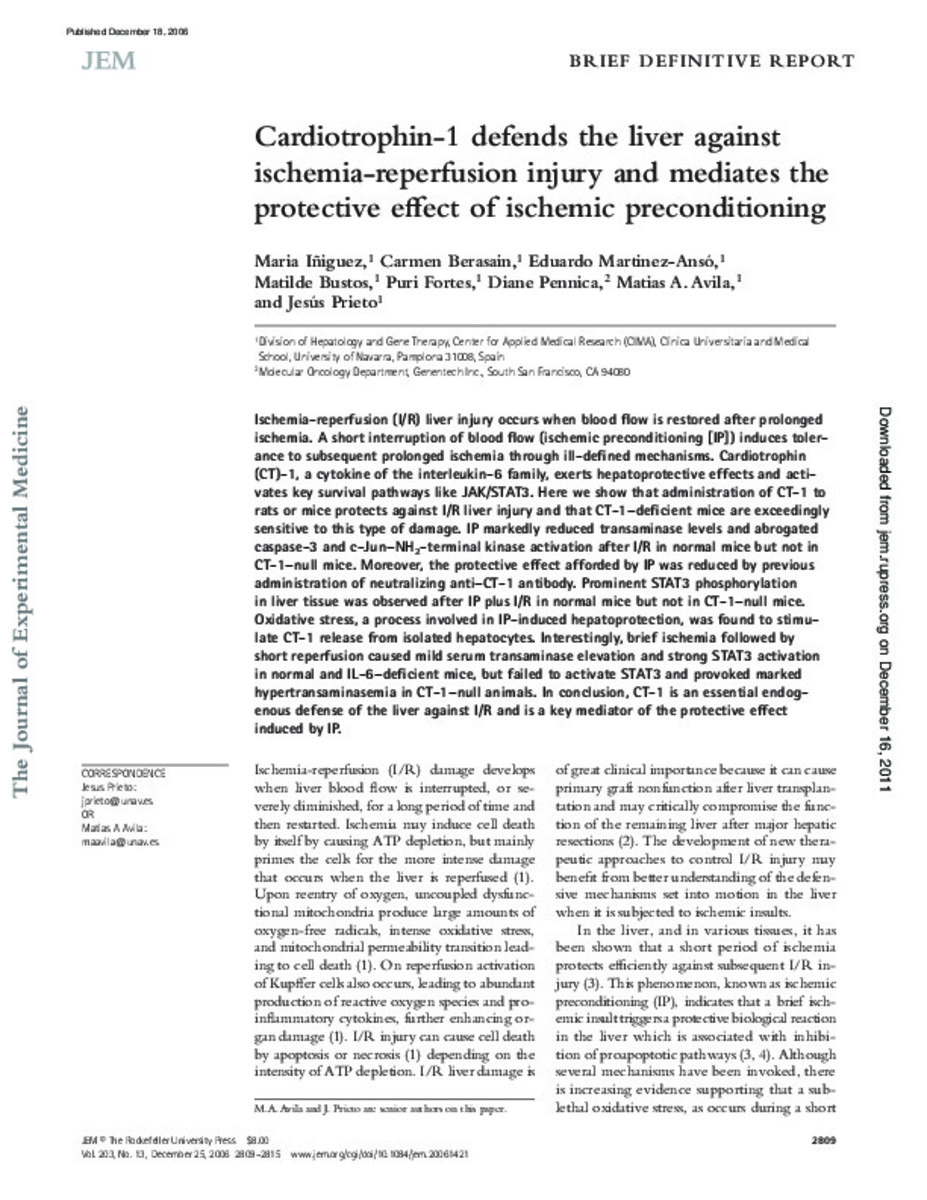Full metadata record
| DC Field | Value | Language |
|---|---|---|
| dc.creator | Iñiguez, M. (María) | - |
| dc.creator | Berasain, C. (Carmen) | - |
| dc.creator | Martinez-Anso, E. (Eduardo) | - |
| dc.creator | Bustos, M. (Matilde) | - |
| dc.creator | Fortes, P. (Puri) | - |
| dc.creator | Pennica, D. (Dianne) | - |
| dc.creator | Avila, M.A. (Matías Antonio) | - |
| dc.creator | Prieto, J. (Jesús) | - |
| dc.date.accessioned | 2011-12-20T12:57:45Z | - |
| dc.date.available | 2011-12-20T12:57:45Z | - |
| dc.date.issued | 2006 | - |
| dc.identifier.citation | Iñiguez M, Berasain C, Martinez-Anso E, Bustos M, Fortes P, Pennica D, et al. Cardiotrophin-1 defends the liver against ischemia-reperfusion injury and mediates the protective effect of ischemic preconditioning. J Exp Med 2006 Dec 25;203(13):2809-2815. | es_ES |
| dc.identifier.issn | 0022-1007 | - |
| dc.identifier.uri | https://hdl.handle.net/10171/20306 | - |
| dc.description.abstract | Ischemia-reperfusion (I/R) liver injury occurs when blood flow is restored after prolonged ischemia. A short interruption of blood flow (ischemic preconditioning [IP]) induces tolerance to subsequent prolonged ischemia through ill-defined mechanisms. Cardiotrophin (CT)-1, a cytokine of the interleukin-6 family, exerts hepatoprotective effects and activates key survival pathways like JAK/STAT3. Here we show that administration of CT-1 to rats or mice protects against I/R liver injury and that CT-1-deficient mice are exceedingly sensitive to this type of damage. IP markedly reduced transaminase levels and abrogated caspase-3 and c-Jun-NH2-terminal kinase activation after I/R in normal mice but not in CT-1-null mice. Moreover, the protective effect afforded by IP was reduced by previous administration of neutralizing anti-CT-1 antibody. Prominent STAT3 phosphorylation in liver tissue was observed after IP plus I/R in normal mice but not in CT-1-null mice. Oxidative stress, a process involved in IP-induced hepatoprotection, was found to stimulate CT-1 release from isolated hepatocytes. Interestingly, brief ischemia followed by short reperfusion caused mild serum transaminase elevation and strong STAT3 activation in normal and IL-6-deficient mice, but failed to activate STAT3 and provoked marked hypertransaminasemia in CT-1-null animals. In conclusion, CT-1 is an essential endogenous defense of the liver against I/R and is a key mediator of the protective effect induced by IP. | es_ES |
| dc.language.iso | eng | es_ES |
| dc.publisher | Rockefeller University Press | es_ES |
| dc.rights | info:eu-repo/semantics/openAccess | es_ES |
| dc.subject | Cytokines/physiology | es_ES |
| dc.subject | Ischemic Preconditioning | es_ES |
| dc.subject | Reperfusion Injury/metabolism | es_ES |
| dc.title | Cardiotrophin-1 defends the liver against ischemia-reperfusion injury and mediates the protective effect of ischemic preconditioning | es_ES |
| dc.type | info:eu-repo/semantics/article | es_ES |
| dc.type.driver | info:eu-repo/semantics/article | es_ES |
| dc.identifier.doi | http://dx.doi.org/10.1084/jem.20061421 | es_ES |
Files in This Item:
Statistics and impact
Items in Dadun are protected by copyright, with all rights reserved, unless otherwise indicated.






